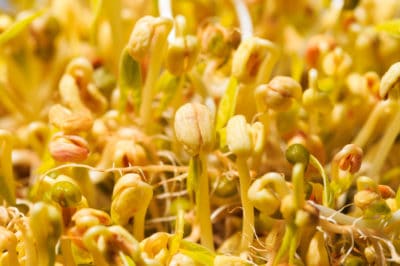About Bean Sprouts
Bean sprouts are the immature shoots of legumes. They include the root, the seed and the first set of developing leaves, or cotyledons. Unless grown in soil, they do not develop root hairs. Typically white, pale yellow or cream colored, if exposed to light they will be green at the top. Texture varies from slightly crunchy to very crisp.
Light vs. Dark
Bean sprouts are usually germinated in the dark. This produces the well-known pale color. However, they can also be exposed to grow lights or sunlight and the leaf ends will turn green. Alfalfa sprouts (alfalfa is a legume), for example, are typically green on the tips. Exposure to light increases the nutritive value of the sprouts.
Choosing Varieties
Beans – as well as other vegetable seeds – can be sprouted at home. Once sprouted, they are used in stir fries, soups or egg dishes. Here are some common kinds of beans used for sprouting:
- Mung beans – this is the classic bean sprout found in Oriental cooking.
- Soybeans – used in many Japanese and Nepali recipes.
- Lentils – lentils are used in Indian cuisine.
Sprouting Beans
Water, air and warmth are all you need to sprout bean seeds. Pick over the seeds to remove rocks and debris. Rinse well and drain. Place in a commercial tray or homemade version such as a plastic tray with holes punched in the bottom. You can also use a glass jar. Replace the jar lid with a piece of mesh or screening.
Growing the Sprouts
It takes about a week to grow sprouts. Keep the jar or tray in a warm, dark cabinet. At least once and preferably twice a day, rinse the seeds/sprouts with cool water and drain thoroughly. Trays can be placed on the level, but a jar should be tipped up slightly so it will drain. Too much moisture can encourage mold.
Nutrition and Digestion
Many seeds cannot be easily digested unless they are soaked, sprouted and cooked. In some cultures, the seeds or sprouts are also fermented. Some beans, such as kidney beans, can be toxic if eaten raw (that includes their sprouts). Sprouting eliminates or reduces gas-forming compounds found in beans. Sprouting also improves the nutritional profile of the seed in many cases.
